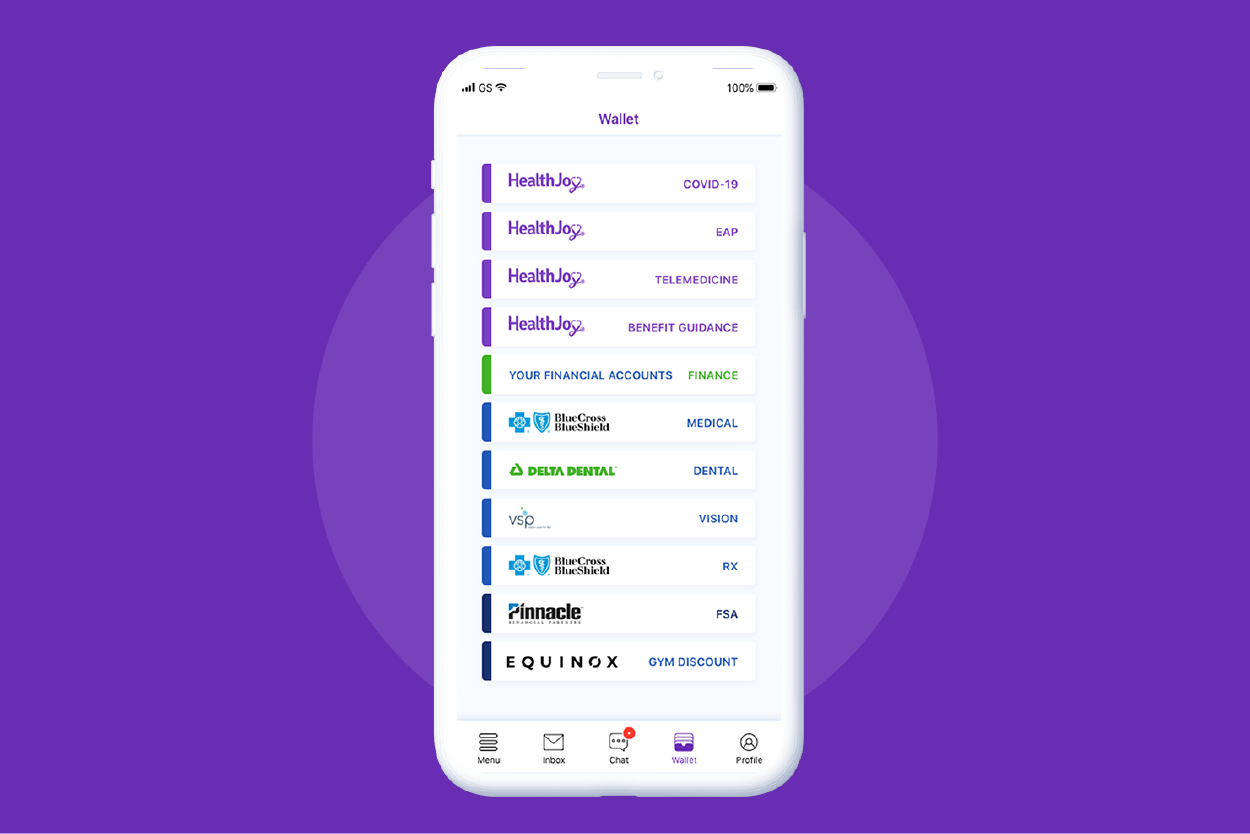How the HealthJoy Benefits Wallet Works
Using benefits is notoriously difficult. It seems that no matter how much is shared during Open Enrollment, when it comes to actually remembering,...
Connected Navigation Platform
Guiding to high-value care
Behavioral Health
Foster a mentally healthy workplace
EAP
Supporting holistic wellbeing
Virtual MSK Care
Reimagining musculoskeletal care
Virtual Primary Care
Powered by smart navigation
Surgery Centers of Excellence
Best-in-class surgical outcomes
Virtual Urgent Care
Immediate care, any hour of the day
Chronic Care
A new approach to chronic care
Integrations
Flexible to any strategy

Human resource administration can act as a significant drag on small to midsize companies, often affecting their bottom line. Professional Employer Organizations (PEOs) are built to solve this problem. As a separate third-party, their exclusive focus is to manage a company’s HR services, including payroll administration, worker’s compensation benefits, health benefits, regulatory compliance, and other various HR support tasks. Their business model of outsourcing HR can offer companies a competitive edge, and more time and resources to devote to the goals their company was built to achieve.
Today, around 14-16 percent of small businesses partner with a PEO to administer their HR and employee benefits. The PEO industry holds between $136 and $156 billion in annual gross revenues and has undergone significant growth since it first took root 30 years ago.
Businesses and PEOs partner together in a unique arrangement known as co-employment. Put simply, co-employment means that the PEO contractually shares some employer responsibilities with their client.
A Client Services Agreement (CSA) contract outlines the PEO’s roles, which may be defined, for example, as:
Specific roles of the PEO differ with each individual agreement, and every PEO offers a unique set of services. However, the co-employment is a standard arrangement for all PEOs and their clients.
Ultimately, co-employment allows the PEO to take over time-consuming HR functions for the client, while simultaneously permitting the client to benefit from the PEO’s robust HR, benefits, payroll, and tax infrastructure. The PEO becomes the “Employer of Record”, taking over all formal administrative HR tasks, while the client continues to exist as the “Worksite Employer”, responsible for the day-to-day management and supervision of employees at the worksite. Both the PEO and its client maintains a strong engagement with employees. PEOs interact with worksite employees primarily through HR channels, whereas the client company interacts with employees in the context of day-to-day operations and production of the company’s goods or services.
There are a few different approaches that a PEO might charge their clients in exchange for their HR services. The first option is charging a fixed percentage of a company’s payroll. Typically, this percentage lies between 3 and 8 percent of the total payroll for a given pay period. For example, the PEO might charge 4% of their client’s total payroll, which is 4% of the gross wage that all employees earned during the payroll period.
Alternatively, a PEO may charge clients a flat fee per employee. This fee may be incurred on a monthly, yearly, or per-check basis. Oftentimes, a PEO will offer several different payment strategies, and allow companies to choose the strategy that is most cost-effective for their individual case. For example, a company with large fluctuations and variation across pay cycles may benefit from paying a flat fee per employee. On the other hand, a company with a large number of part-time employees would lose out by paying a flat per-employee fee and may instead want to choose a payment that is based on a percentage of their total payroll.
A recent white paper from the National Association of Professional Employer Organizations (NAPEO) found that the revenue growth of PEO firms was twice as high as that of comparable non-PEO firms (NAPEO, 2017). It also found PEO users to have lower employee turnover and significantly lower rates of going out of business. The competitive edge that PEOs provide stems from their specialization, expertise, and large employee pool, all of which lead to efficiency and cost-containment in operations.
First, because of the sheer size of their employee pools (typically thousands of lives), PEOs are able to offer incredibly competitive large-group health plan rates to their clients. These plans simultaneously provide high-quality coverage and low rates that a small to midsize business would be unable to achieve on its own. These plans are made possible through the PEO’s master benefits plan– an aggregation of all of the PEO’s smaller groups’ employees under the umbrella entity of the PEO. Insurance carriers and PEOs find it mutually beneficial to negotiate low rates: the carrier wins the enrollment of the PEO’s large pool of employees, and the PEO is able to secure low premium rates.
The same advantages that PEOs enjoy in regards to health insurance plans apply to all other forms of employee benefits. In fact, PEOs give access to 401(k) plans, dental and life insurance, dependent care, and other benefits that are often difficult for small businesses to provide on their own. Without a PEO, small businesses are subject to community-rated policies that do not stack up against the benefits offerings of larger companies. Still, companies should be wary of high rate increases or even termination of coverage under the master benefits policy should they incur catastrophic claims or exhibit poor performance.
PEOs also offer streamlined operations through experienced professionals who specialize in HR administration. Not only have these professionals mastered the art of efficient administration of payroll, accounting, and legal duties, but they possess the know-how needed to tackle tough employee situations (discrimination allegations, complex benefits arrangements, etc.) that would pose a headache for firms who have never dealt with such issues.
Compliance is a realm where PEO expertise can potentially save employers a lot of hassle. Navigating the regulatory sphere, whether it be at a local, state, or federal level is daunting, to say the least. Employers face increasingly complex regulations at every corner, whether it be in HR, health care, or taxes. Employment laws are constantly evolving, making it more and more difficult to navigate and stay compliant in order to avoid fines. Small and midsize businesses (SMBs) breathe easy after partnering with a PEO, because their HR services maintain compliance with changing laws, as they are constantly updated by specialists with extensive regulatory knowledge. This is especially beneficial for multi-state firms, who have to juggle different and complex employment practices in every state since each has their own set of unique employment laws.
Also, companies with high workers’ compensation risk can benefit greatly from the protection of a PEO. Although firms often don’t anticipate workers comp claims until it’s too late, these claims are often so devastating that they can compromise the financial stability of an SMB. Luckily, PEOs provide strict return-to-work policies and investigation of questionable or fraudulent claims in order to minimize claims costs. In addition, PEOs carefully manage workers’ comp deadlines, updates in any laws, and documentation to ensure that costly mistakes are not made.
PEOs get excited about HR Tech because it concerns their core business. These technologies might look like anything from an employee recruitment software, to an employee wellness program, to a comprehensive employee benefits guidance app. These technologies have the potential to not only simplify the HR functions that PEOs outsource for their clients, but also to add significant value and employee engagement for the many individuals whose employers partner with a PEO.
PEOs that currently make the most out value-adding HR tech are seen as ever-more attractive to their prospective clients, who are always looking for ways to improve their employee retention and attract top talent. The best HR tech tools offer the double-sided advantage of improving employee benefits packages while simultaneously achieving cost-savings for the employer. For example, HealthJoy is a healthcare benefits app that employees can use to dynamically engage with their own health coverage, which naturally leads to lower costs for their employers.
The Professional Employer Organization offers a competitive edge and increased survivability for businesses during a time where small advantages can make a critical difference. When a small to midsize company is stretched thin, it can be overwhelming to run daily HR operations that aren’t contributing to sales or revenue but are still essential. PEOs free up the time and resources devoted to HR administration so that employers are free to focus on what matters most– growing their business and delivering their bottom line. More and more, businesses are finding it hard to ignore the returns on efficiency, stability, and affordability that the PEO brings to the table.

Using benefits is notoriously difficult. It seems that no matter how much is shared during Open Enrollment, when it comes to actually remembering,...

COVID has changed the landscape of the American workforce in so many ways — from the Great Resignation and labor shortages, to variants and remote...